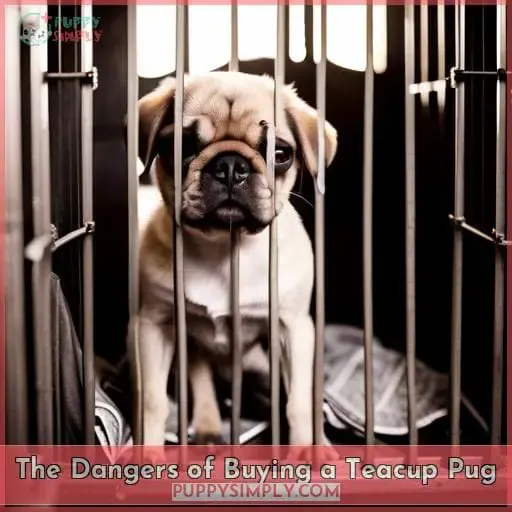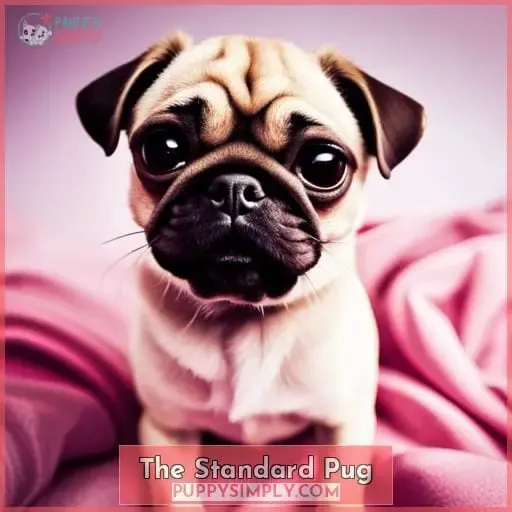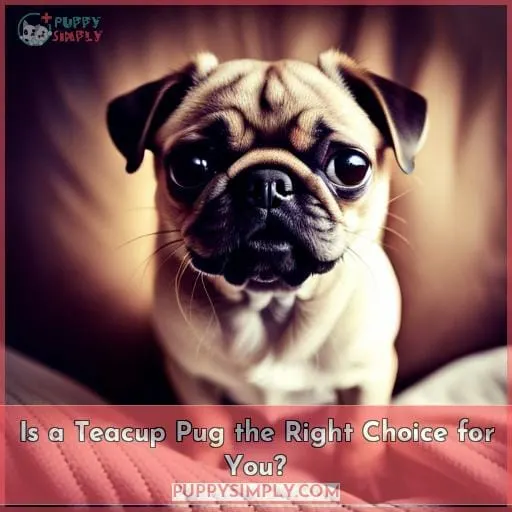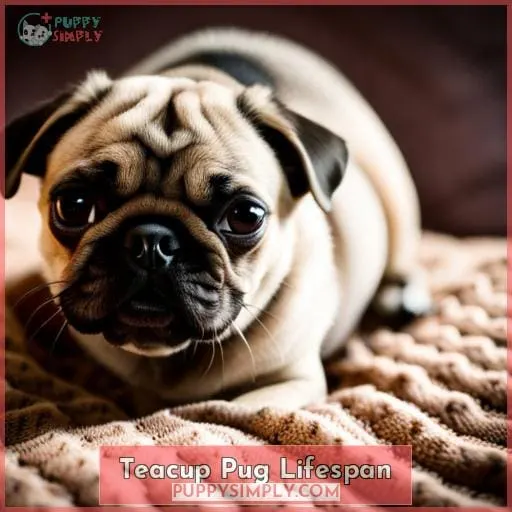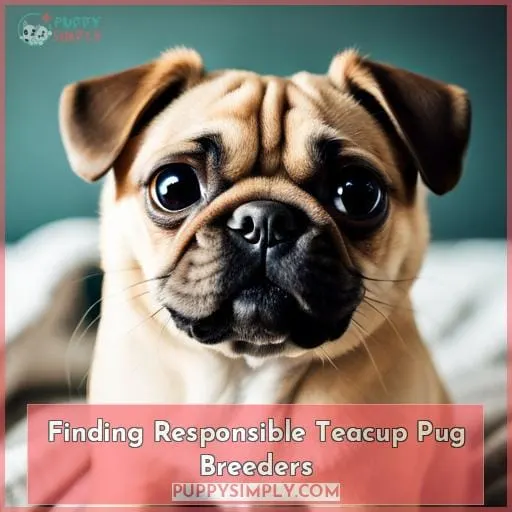This site is supported by our readers. We may earn a commission, at no cost to you, if you purchase through links.
 If you’re after a pint-sized canine companion, teacup pugs may have caught your eye. But before you take the plunge and bring home one of these pocket-sized puppies, it’s important to know what to expect.
If you’re after a pint-sized canine companion, teacup pugs may have caught your eye. But before you take the plunge and bring home one of these pocket-sized puppies, it’s important to know what to expect.
From their health risks to their life expectancy, this article will cover everything related to teacup pugs – from how they’re made and why they exist in the first place through to whether or not they are right for you.
Table Of Contents
Key Takeaways
- Small purebred pugs unethically bred, resulting in health issues like respiratory problems.
- Teacup pugs have no official breed standards and are just a marketing term.
- Teacup pugs are prone to health risks such as dwarfism, hip dysplasia, and hydrocephalus.
- It is important to research and support ethical breeders instead of supporting teacup breeding practices.
What is a Teacup Pug?
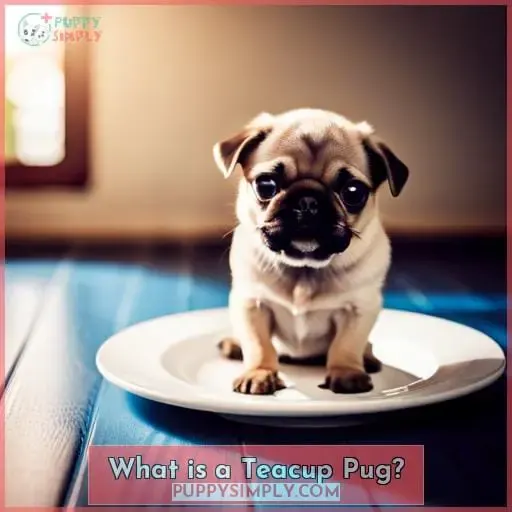
You’d be forgiven for thinking a Teacup Pug is as tiny as a teacup saucer – but this breed is actually just small purebred pugs that have been bred unethically, resulting in potential health issues and suffering like an unwelcome houseguest.
A TC Pug can range from 6-10 inches tall, weighing between 3-10 pounds. This type of miniature pug has become increasingly popular due to its adorable size – however, there are many risks involved with breeding them so small.
These dogs are prone to brachycephalic airway obstruction syndrome (BOAS), which causes difficulty breathing and other respiratory problems such as tracheal collapse. They may also suffer from hypoglycemia or even hip dysplasia due to their fragile bone structure.
As well, these dogs typically have shorter life spans than larger breeds and require frequent wrinkle cleaning and brushing of their rose ears – making the costs associated with owning one much higher than expected!
It’s important that potential owners avoid supporting unethical teacup breeding practices by opting for AKC standard Pugs instead. These loyal companions come in sizes ranging between 10-14 inches tall at 14-18 lbs.
How Are Teacup Dogs Made?
Unethical breeding practices are often used to create teacup dogs, resulting in tiny canines with fragile bones and health problems that require frequent veterinary care.
- Irresponsible breeders will crossbreed pugs and Chihuahuas to create smaller versions of the beloved canine companions – ones which don’t have any official breed standard or classification.
- These pocket pups typically measure between 6-10 inches tall, weighing only 3-10 pounds – but come with potential risks such as hypoglycemia, trachea issues, hip dysplasia, or even shorter lifespans than larger breeds.
- Not only do these little furballs need constant wrinkle cleaning and brushing for their rose ears, but they also require much higher vet bills due to their delicate nature!
Unfortunately, supporting unethical Teacup Pug breeding is still a problem today as people flock towards this adorable size without knowing the suffering it can cause both financially and emotionally in terms of potential health issues.
By opting instead for an AKC Standard Pug at 10–14 inches tall and 14–18 lbs.
The Dangers of Buying a Teacup Pug
If you are considering purchasing a teacup pug, it’s important to be aware of the health risks associated with this type of unethical breeding. Dwarfism and various medical complications can arise from these small-sized dogs, leaving both pet owners and their beloved companions in distress.
Dwarfism
You may be tempted by their small size, but buying a Teacup Pug often leads to dwarfism and other serious health complications that can cause your pup a lifetime of suffering. Unethical breeders are responsible for propagating these defects, with hip dysplasia and hydrocephalus being common symptoms related to the practice.
To avoid such risks, it’s important to monitor your dog’s body weight carefully. Only feed them wet foods specifically designed for smaller breeds.
Though they may look cute in pictures or videos online, don’t let yourself get taken advantage of just because you think miniature pugs are too adorable not to buy.
Health Risks
Be aware that these tiny pups can come with a host of health risks, from hypoglycemia to tracheal issues and an increased risk of injury due to their fragility. Breeding small versions of dogs has become increasingly popular in recent years, but it’s important to recognize the common health risks associated with teacup pugs before making such a decision.
These risks include higher vet bills as well as long-term complications like genetic disorders and breathing problems. Not only are these animals more prone to developing illnesses than larger breeds, they require extra attention and care due to their size – something many owners may not be prepared for or able to provide on top of other commitments.
Before getting one for yourself or your family, make sure you’re fully informed about all the potential consequences involved so you can make an educated decision about whether this breed is right for you!
The Standard Pug
The Standard Pug is a popular canine companion, renowned for its distinctively comical appearance. These intelligent little dogs require regular grooming to keep their short coats clean and free of mats, but they have minimal shedding compared to other breeds.
With an easygoing temperament that loves companionship and playful activities with its owners, the pug can make a loyal pet or family member if given enough attention.
Appearance
You’ll recognize a pug by its signature wrinkles and short, stocky body. Also known as teacup pugs, they are bred for their small size—usually about 6 to 10 inches tall with weights ranging from 3-10 lbs.
As one of the oldest breeds in existence, they have button ears and a brachycephalic face that make them unmistakable! They come in various colors including black or fawn with white markings on their forehead and chest area.
This designer breed may be small but is full of energy; it’s important to provide your pup with plenty of exercise both mentally and physically if you plan on owning one! These faithful companions will require frequent grooming especially around those folds which can get pretty stinky if not taken care of properly.
Teacup pugs are undoubtedly adorable little creatures so don’t forget to show yours lots of love!
Grooming and Shedding
Regular brushing and cleaning of the wrinkles is necessary to keep your pup looking their best! Teacup pugs usually have single coats with wiry fur that require frequent grooming. Double coat breeds may need more attention depending on how thick the undercoat is.
Be sure to check for any signs of hydrocephalus, which can be seen by a bulging fontanel or an unusually large head size in comparison to its body mass index (BMI).
Keeping these things in mind will help maintain your teacup pug’s hygiene as well as keeping them happy and healthy.
Temperament
Your teacup pup is known for its gentle and friendly demeanor, but don’t underestimate their independent streak! Toy pugs are an incredibly popular breed due to their small size and playful nature. Although they belong in the toy group category of dog breeds, they can still suffer from serious illnesses like Pug Dog Encephalitis or other health issues that may be related to being a small dog breed.
Despite this risk, these loyal companions provide unconditional love and make excellent family pets if given proper care.
With patience comes rewards when it comes owning one of these delightful little pooches.
Half-breeds and Cross-breeds
Be wary of cross-breeds like Chihuahua and pug mixes, as they can be prone to health issues – but how much are you willing to risk for an adorable pup in a small package? A mix between the two breeds could produce a tiny toy poodle or Pekingese, Shih Tzu or Maltese.
However, these mixed breeds have no official breed standards from kennel clubs and may not always look like either parent.
They tend to be clingy with their owners due to their independent streak, require lots of exercise and mental stimulation, which makes them great companion dogs if given enough attention. Though some might argue that there is nothing wrong with owning one of these hybrid crosses, it’s important that we don’t support unethical breeding practices by purchasing animals bred solely for profit without any care for wellbeing.
It’s best avoided in order to prevent weak genes being passed down, leading to potentially life full of suffering from health problems such as hypoglycemia, trachea issues, or shorter lifespans.
Is a Teacup Pug the Right Choice for You?
Before making the decision to bring home a pint-sized pup, consider whether a teacup pug is really the right choice for you. An official teacup breed standard does not exist, and it has been described as just another marketing term.
The AKC standard pug measures between 10 to 14 inches with an ideal weight of 14 – 18 lbs, which other clubs follow suit. This means that there are no true breeds such as mini, micro, or toy pugs – only small purebreds.
Teacup Pugs come with risks. They can suffer from hypoglycemia due to their low body fat percentage and have trachea issues due to their undersized windpipe. These factors contribute towards a shorter lifespan than your average pug, which may result in high vet bills if health problems arise throughout its lifespan, leaving them fragile and easily injured, potentially leading to suffering through much of its life cycle.
Pugs were once favored by monks and emperors alike for having easy tempers, yet they require frequent wrinkle cleaning along with regular brushing sessions. They do not need lots of exercise but still make great companions nonetheless! Yet despite being one of the oldest breeds around, avoiding supporting unethical breeding practices is key when considering these pocket-sized pooches.
Teacup Pug Lifespan
You may be tempted by the idea of a toy dog, but when it comes to pugs, you should know that smaller pugs don’t always mean healthier ones. While there are no official breed standards for teacup pugs out there, and many come with higher prices than their larger counterparts, they pose more risks in terms of health problems due to their size.
Hypoglycemia is common among these breeds because of their low body fat percentage, and trachea issues can arise from an undersized windpipe – leaving your pup fragile and easily injured with a shorter lifespan than other standard-sized dogs might have.
Not only this, but teacup puppies require frequent wrinkle cleaning along with regular brushing sessions, making them quite high maintenance! To avoid supporting unethical breeding practices, make sure you’re aware of what exactly goes into getting one before committing.
These tiny pooches were bred solely for profit without any care given towards wellbeing or quality life cycle.
Finding Responsible Teacup Pug Breeders
To ensure you’re supporting ethical practices, research responsibly bred teacup pugs – those without health risks or a shortened lifespan. With an adorable package in such a small size, it’s easy to be tempted by these little guys; however, the potential issues that come with them can lead to lifelong suffering and expensive vet bills.
When looking for one of these breeds – affenpinscher, biewer terrier, pug shih tzu, and Yorkshire terrier – make sure they are reputable sources who provide full disclosure about their breeding history and any known health conditions.
It is also important to only buy from breeders who follow all official standards set out by kennel clubs like AKC when it comes to raising puppies properly with adequate nutrition levels so as not to encourage unhealthy breeding trends again in future generations of teacups.
It may take some extra effort, but finding responsible breeders will help ensure your puppy has the best chance at living its fullest life possible! Before making your decision, double-check references given from previous customers as well as speak directly with veterinarians if available before committing either financially or emotionally to bringing home one of these tiny furballs.
Frequently Asked Questions (FAQs)
What are the health risks of owning a Teacup Pug?
Owning a Teacup Pug poses risks of hypoglycemia, tracheal issues, and shorter lifespans. It can also lead to costly vet bills due to their fragility and susceptibility to injury.
What type of care do Teacup Pugs require?
Owning a Teacup Pug requires frequent grooming and wrinkle cleaning, regular brushing, minimal exercise needs, but mental stimulation to curb misbehavior.
How much exercise does a Teacup Pug need?
You need to give your Teacup Pug regular, daily exercise. Short walks and play sessions are perfect for this breed’s small size and low energy levels.
Are Teacup Pugs suitable for families with children?
Teacup Pugs may not be suitable for families with children due to their fragility and the need for frequent wrinkle cleaning. While they have an easy temperament, their small size can make them prone to injury and require extra attention.
Crossbreeding Pugs and Chihuahuas can offer a better option – affectionate, intelligent but stubborn, with the potential for health issues.
What is the typical cost of a Teacup Pug?
The typical cost of a Teacup Pug can vary greatly. Expect to pay anywhere from several hundred dollars up to thousands, depending on the breeder and size.
Conclusion
At the end of the day, it’s all about what’s best for you and your pet. A teacup pug might seem like a cute, cuddly solution, but as the saying goes, looks can be deceiving. With its potential for dwarfism, health issues, shorter lifespan, and hefty vet bills, a teacup pug is more of a liability than an asset.
If you’re willing to put in the time and resources to provide the best possible care, then you may be a great fit for a teacup pug.
On the other hand, if you’re looking for a loyal companion with a long lifespan, you’re better off going with a standard pug.


